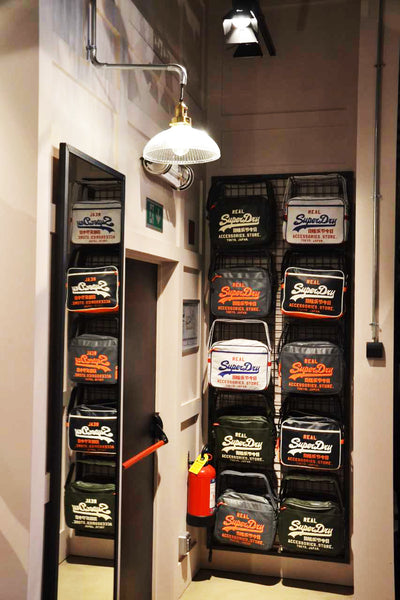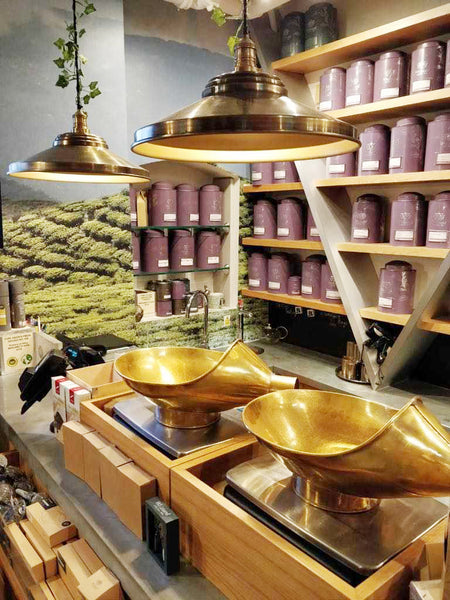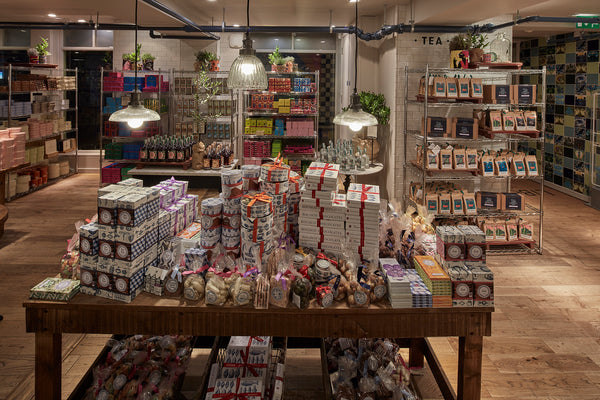Interview With Paul Nulty
Lighting is playing a more critical role in retail interior design; it’s about creating an immersive experience for shoppers. Rather than just having sufficient light, retail stores and interior designers are focusing more on creating an interior that reflects a brands personality, with lighting playing an essential role in doing so. We had the chance to speak to Paul Nulty, the founder of Nulty, a bunch of award-winning lighting designers who focus on creating an atmosphere with lighting rather than just fixtures and fittings. They’ve worked with brands such as Estee Lauder, DKNY, Selfridges and Bloomingdales, so we were more than pleased to get the chance to speak to Paul and get his opinion on retail lighting.
Tell Us A Little Bit About You And How You Decided To Get Involved In Lighting Design?
Weirdly I fell into lighting design; I didn’t grow up wanting to be a lighting designer, I went to university and studied theatre design and realised I was emphasising more and more on the role that lighting played on the stage rather than the materiality of a stage set. In my mind, the world is a stage and if there is an opportunity to give it better lighting then so be it, and that’s maybe why I like retail design so much because in a way it is about the theatricality of selling, especially now it is becoming much more experiential. For me its ultimately about connecting people and spaces. That may be in retail where you connect the customer to the brand or in people’s homes making them cosy and loving.
How Does Retail Lighting Differentiate From Other Commercial Lighting?
Retail lighting is all about emotionally connecting the customers to the brand, connecting their personal and brand identity into one. Retail lighting is all about the psychology and sociology of lighting design, and if it’s done well, a retailer will be able to see this in their bottom line. Commercial lighting is about placemaking and making the space just right for people to dwell in, whereas retail lighting is more than that it’s about connecting an entity with the brand.
What Has Been Your Favourite Retail Lighting Design And Why?
This is a very difficult question to answer; I love them all! The Superdry project on Regent Street because of the journey we took the client on, they wanted something to look like Abercrombie and Hollister, and we explained to them that it doesn’t have to be as dark and instead took them on a journey which ended up with a better project as a result.
Bloomingdales in Kuwait was another; this project took lighting in a department store in a totally new direction, I’m very proud that it creates a very different narrative and brand identity. With TK Maxx we were able to technically create lighting which decreased their energy by 40% and increased their light levels by 20%-25%.
The success of a project has to do with more than just how beautiful it looks; it’s about taking the retailer on a journey, improving their space and getting better sales. Technology, engineering, sociology and all the multifactual elements that play a role in bringing it to life, in particular, I love the combination of technology and creativity as that’s what it’s all about.
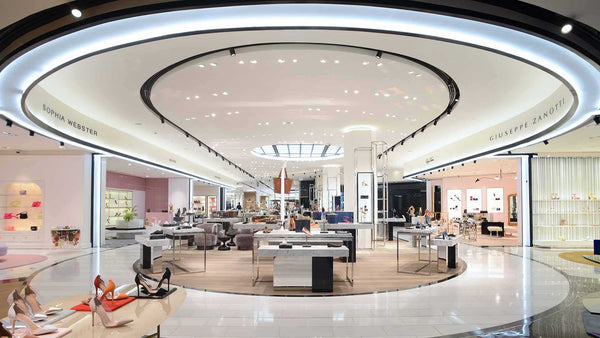
Project Bloomingdales Kuwait by Paul Nulty (Image supplied by Paul Nulty)
What Lighting Layers Work Best For Retailers And Why?
The success of a good retail schema is the juxtaposition of all five layers of lighting. Firstly, there is accent lighting that lights up the products in a retail store; then there is ambient Lighting - this is low-key lighting in a store to ensure there is enough light. Feature lighting which is also known as decorative lighting is the lighting that represents your brand and gives character. Signage lighting is the lighting that comes from all the signs in a retail store, and last but not least, there is audiovisual lighting this comes from the screens that retailers have inside the store.
While some retailers have one predominant layer above the rest or use three out of five, it is how you blend these layers together that creates a successful schema.
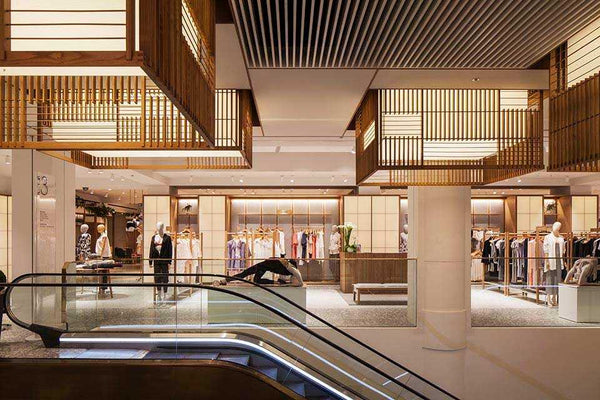
Project Selfridges Body Studio by Paul Nulty (Image supplied by Paul Nulty)
How Does Lighting In Retail Create An Atmosphere And Create An Experience?
It depends on how the brand wants to come across; it must work well with the interior and also reflect the brand identity. A great example is Hollister; their target audience is highly affluent college students, aged 16 – 25 and their interior really reflects that. Apple wants to come across as an approachable, easy and natural brand, the lighting in an apple store represents daylight even though they are using a lot of energy.
How Does Lighting Complement The Style Of A Retail Shop?
This is where you must talk to your lighting designer - Do you want to guide people into the store? Do you want it to feel dark and moody, or light and airy? We want to ask these type of questions as it defines the user’s experience.

Project Selfridges Opticals by Paul Nulty (Image supplied by Paul Nulty)
What Kind Of Interior Retail Environments Do Customers Like To Spend More Time In?
They like to spend more time in retail environments that are all about the experience rather than just to sell. We worked on the Dyson store in Japan a few years ago, and everything in the store is spotlit, and it elevates the Dyson products, putting the focus on the beautiful engineering objects.
How Do You Think Our Lights Fit Into Retail Stores?
When it comes to decorative lighting you are the icing on the cake, Superdry was all about decorative lighting in certain areas. Decorative lighting is a way to start connecting with your brand identity, for example, if you’re All Saints or Superdry, then you absolutely want a lot of industrial features in there. It’s all about the aesthetic and how to embrace the brand identity. In DKNY we used hand-blown glass pendants that were beautiful and were sophisticated and tied in really well with the brand.
Project Superdry by Industville - Brooklyn Glass Dome Pendant – 12 Inch, by Industville (Image supplied by Superdry)
Can Retail Lighting Boost Sales?
Absolutely! Yes! We worked with a big European retailer, and they saw their sales go up 40%. We worked with a retailer on Bond Street their sales went up 17%, we worked with a football store up in Manchester their sales went up 12.5%. So yes, is the short answer; unfortunately, there is very little scientific evidence to back it up as a lot of it is anecdotal evidence. There are other factors influencing it as well, but lighting does make a big difference to sales.
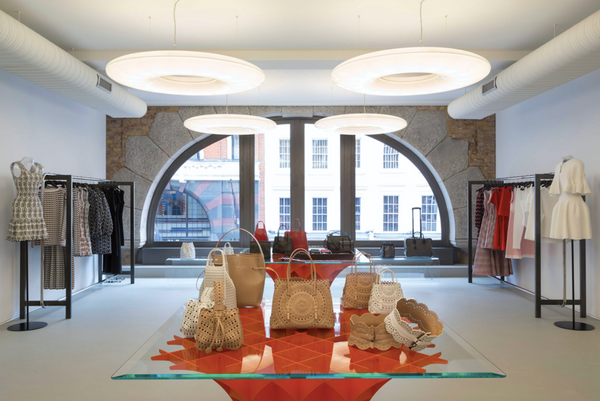
Project Alaia, Regent Street by Paul Nulty (Image supplied by Paul Nulty)
Does The Quality Of The Lighting Play A Role?
Absolutely! Particularly with LEDs, more often than not two products will look the same but perform very differently. One of the phrases we use is ‘painting with light’ and what we mean by that is taking a black space taking light to reveal the space.
The quality is critical especially in the fashion world; you do not want to go and buy a red jumper to go home to realise it is not that colour. In make-up stores it is vital as well, you need it to show the true colour, you can’t have customers going home and finding out it is the wrong shade. That happens all the time because people do not understand the importance of high-quality lighting, we champion all the time the very best quality of light. If it means spending a bit more but adding value to the bottom line, then its good value for money.
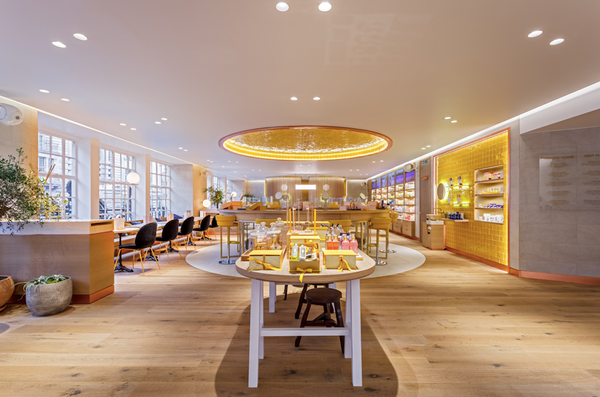
Project L’occitane, Regent Street by Paul Nulty (Image supplied by Paul Nulty)
What Benefits Shall Retailers Expect To See With Great Retail Lighting?
Increase in sales, increase in brand awareness and lifestyle identification. Take any brand, for example, Victoria’s Secret; it’s dark, moody and it’s phenomenal when you walk in. People identify with that brand, and they identify with that lifestyle, so, therefore, that’s great. There should also be benefits such as energy reduction, so again this adds to the bottom line so therefore that increases profitability.
Project Whittard by Industville - Brooklyn Giant Step Pendant – 18 Inch – Brass, by Industville (Image supplied by Whittard of Chelsea)
Which Of The Industville Lights Do You Think Fit Perfectly For Retail? What Are Your Thoughts On Our Waterproof Range?
It really depends on the retailer, the messaging and the style of the store; you have a very big range with some lovely products. There are a lot there which we like and use. There was a gap in the market for stylish waterproof lighting, and what you have here is a good value!
Project Liberty by Industville – Brooklyn Glass Cone Pendant – 7 Inch & Brooklyn Glass Dome Pendant – 8 Inch, by Industville (Image supplied by Liberty)
It was great to speak to Paul about how essential lighting is in interior design and delve deeper into the subject. Here at Industville, we have a wide range of retro lights, suitable for all retail stores. Whether you’re looking for accent, decorative or ambient lighting, we have them all covered; you can browse our range of lights here and get a sneak peek into some of our lights in retail stores!





















